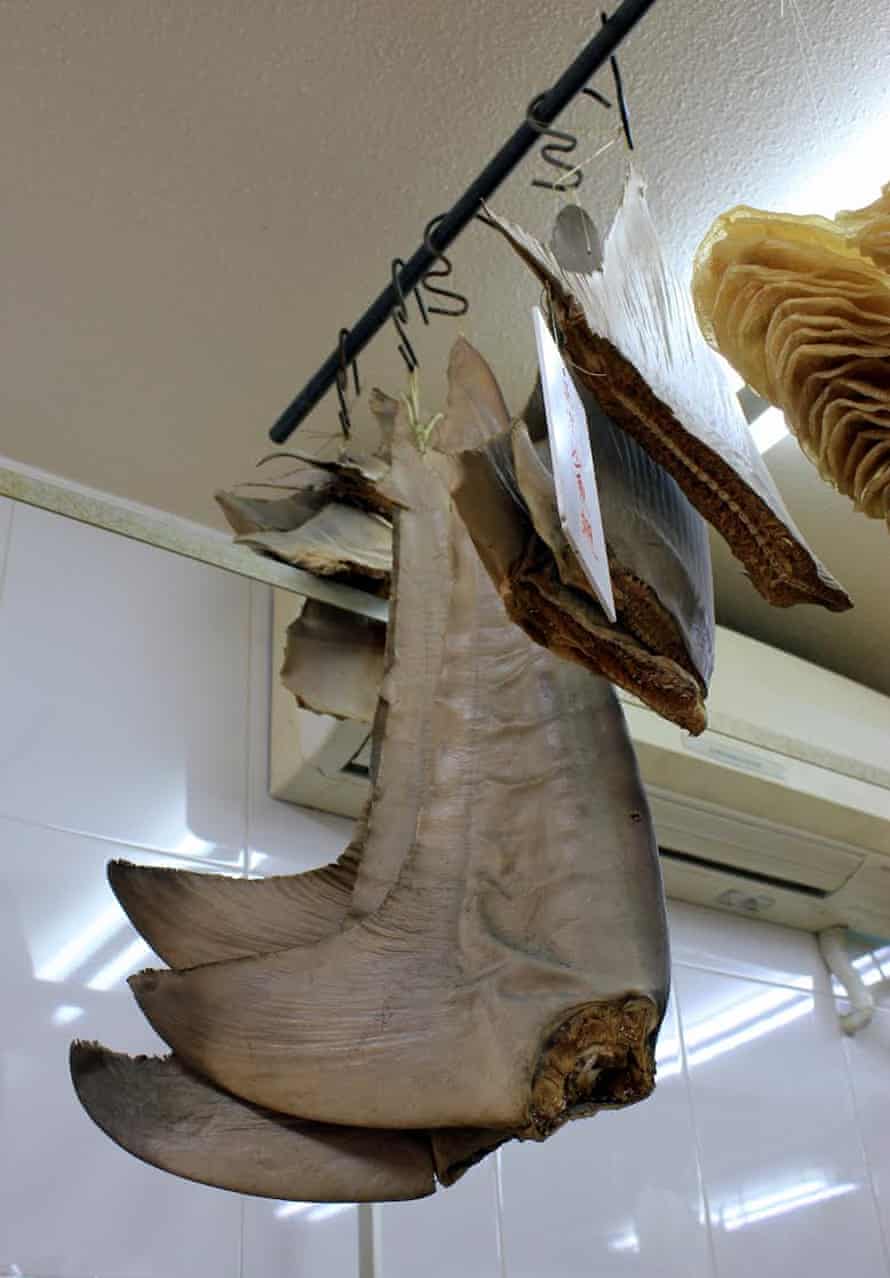What Country Is Shark Fin Soup Is Served What What Country Is Shark Fins Art
I t's early February two days earlier the Chinese New year's day. I am in Hong Kong and at that place are shark fins everywhere, to suit all types of consumer. You can buy them in general food stores, pharmacies and fishing villages. You lot tin buy modest ones in plastic bags, multipacks or single big ones with festive cherry-red bows tied around them.
The cartilage in the fins is usually shredded and used primarily to provide texture and thickening to shark fin soup, a traditional Chinese soup or broth dating back to the Vocal Dynasty (960-1279). The dish is considered a luxury particular embodying notions of hospitality, status and good fortune.

The origin of the dish can exist traced to the Emperor Taizu of the Northern Song, who reigned from 960-976. It is said that he established shark fin soup to showcase his power, wealth and generosity. The dish's popularity increased during the Ming Dynasty (1368-1644) every bit a consequence of an admiral of the imperial navy, Zheng He, who commanded expeditionary voyages around Asia and East Africa from 1405-1433, bringing back fins that fishermen had discarded. From this point onwards shark fin soup became an established dish and by the fourth dimension of the Qing Dynasty (1644-1912) was in high need.
It is not surprising that the popularity of a dish embodying such elite and elitism declined once the Chinese Communist Party came to power in 1949. However, by the late 1980'southward Red china had undergone far-reaching market-economy reforms which led to a rapidly expanding upper and middle course, who were eager to showcase their new-plant wealth; shark fin soup once over again became a fashion of doing so. Considering that the price per bowl tin range from merely HK$5 (45p) to an incredible HK$2000 (£180) depending on the blazon, style and grooming of the shark fin served, the dish is a feasible option for a big number of people.
This increase in demand has led to sharks being targeted solely for their fins. Shark finning involves the removal and retention of the shark fins on board, whilst the balance of the shark (under almost circumstances the fauna is still alive) is and then discarded dorsum into the bounding main.
The fishermen carrying out this practice are often enticed past brusque-term gain. The cost paid for the fins is higher than for their normal catch, all the same they are paid relatively little when compared to the money made to a higher place the chain by the fin traders. In west Africa, shark fishermen often quickly go trapped in a cycle of debt [pdf] with South East Asian fin traders. Local shark populations are quickly depleted, pregnant the fishermen must travel further distances in search of sharks; in order to do then they require larger vessels and more fuel. The money for this is loaned to them by the fin traders, who then deduct a proportion of this from any catches. With decreasing shark numbers the fishermen find it increasingly harder to break even.
I first became aware of this do in 2003, during my undergraduate degree, when writing a paper on the conservation status of the blueish shark (Prionace glauca), a highly migratory pelagic species. Back and then they were considered to be the almost heavily fished shark in the world, with an estimated annual fisheries mortality of between 10 and 20 million individuals. Ten years after, in 2013, I had the hazard to dive with blue sharks in the waters higher up the Azores Bank to the southward west of Faial Island. It was easily one of the nearly memorable dives I take e'er washed: the sharks were inquisitive, sleek and stunning, consummate with their pilot fish companions accompanying them through their open up bounding main migration.
Following the dive, one of the operators told us that some of the sharks we had dived with today would probably end upwardly on the deck of a fishing gunkhole next calendar week. Sadly, a study by Queiroz and colleagues in December 2015 suggests that this could well accept been the case. The study used satellite tracking information from six shark species across the North Atlantic together with simultaneous GPS tracking of the entire Castilian and Portuguese longline vessel angling fleet. Data analysis revealed an 80% overlap of fished areas with shark hotspots, this is particularly bad news for the blue shark which comprises around 70% of the full pelagic shark catches.

With molecular genetics, the identification of species is possible fifty-fifty afterward the fins have been removed, using diagnostic DNA sequence tests with species-specific PCR primers. These techniques are the nearly reliable way to make up one's mind which species are the near heavily traded. This is peculiarly important every bit traders tend to allocate fins using Chinese name categories on the footing of market value. This means the human relationship between the market place category and species becomes unclear.
One time a species breakdown becomes available, however, it is clear that fin trading constitutes a threat to a wide range of species. For case, the figures from a 2006 study evidence that in Hong Kong for the flow studied, the auctioned fin weight was dominated past the blue shark, which made up over 17% of the overall market.Other taxa identified were the mako (Isurus spp.), thresher (Alopias spp.), tiger (Galeocerdo cuvier), silky (Carcharhinus falciformes), dusky (C. obscuris), bull (C. leucas), oceanic white-tip (C. longimanus), sandbar (C. plumbeus) and hammerhead (Sphyrna spp.). Ii of these hammerhead species (scalloped and swell) are classified as endangered.
On the positive side, in recent years there has been an increasing public awareness of the shark fin merchandise and the need for conservation management of elasmobranchs worldwide. The legislative changes in response to this accept varied greatly between countries, with some declaring all shark angling illegal (Palau) and others stating that although the practice of finning is illegal, importation and merchandise from other regions is not (Canada).
In the EU, regulations were strengthened in 2013 with the insistence of sharks beingness landed with fins naturally fastened, a method widely acknowledged equally the most reliable means for implementing a finning ban. This was a vast comeback on the original 2003 legislation which outlined a fin landing weight of five% ratio of the total shark'south weight. However, this presented a loophole allowing more fins to be landed per whole brute, due to the fact that the primary fin fix actually weighs around 2% of the total body weight.

Despite the efforts of entrada groups, conservation scientists and authorities bodies, the existent power to end the fin trade is firmly rooted in the consumer. Without a doubt in Hong Kong there is still ample opportunity to purchase shark fins, but does this mean the product is still in high demand? My investigations revealed a mixed response. Some people told me they had stopped eating shark fin soup birthday, others told me they still both expected it and enjoyed information technology at wedding and New Twelvemonth banquets; other people said they ate information technology regularly.
For those who had stopped eating information technology, the reasons given were a combination of the upstanding implications as well as recent evidence showing that a percentage of shark fins assessed from 5 Chinese cities (including Hong Kong), contained mercury and methylmercury in concentrations high enough to be considered unsafe for human consumption. People who ate it at special occasions saw the dish as an important part of their culture and didn't desire that to be lost, and those who ate information technology regularly simply saw it as their right to do then, despite being enlightened of the environmental and potential health impacts.
The differences in attitudes of the public is encouraging, although a trader explained to me that his fin sales had increased by 90% over the Chinese New Yr menstruation, suggesting that this dish is nonetheless a long style from being relegated to history. Continued public sensation, constructive legislation and ongoing scientific research remain essential to the future safeguarding of many shark species.
Source: https://www.theguardian.com/science/blog/2016/mar/10/shark-fin-soup-a-dangerous-delicacy-for-humans-and-sharks-alike
0 Response to "What Country Is Shark Fin Soup Is Served What What Country Is Shark Fins Art"
Enregistrer un commentaire